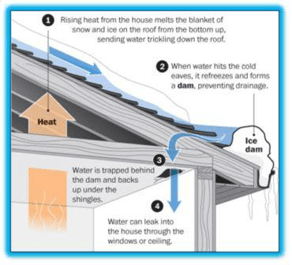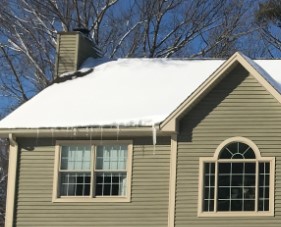
As another crazy New England winter descends upon us, whether you own or manage property you should be aware that icicles hanging from the gutters can mean trouble. This could be a sign of severe damage occurring due to ice dams and attic condensation.
Preventing Roof Edge Ice Damming
These two forms of water damage are typical of buildings and homes in cold climates. The structural problems that can occur are often complicated, tricky to fix, and can catch you off guard during winter months.
So, what are ice dams? What causes attic condensation? And if you've got either, what can you do?
What are Ice Dams?
An ice dam is a wall of ice that forms at the edge of the roof, usually at the gutters or soffit. When it forms, the water backs behind the ice dam and creates a pool. This pool of water can leak into your home and cause damage to walls, ceilings, insulation, and other areas.
What Causes Ice Dams?
Ice dams are usually caused by a heavy snowfall and improper ventilation in the attic. This causes warmer areas in your attic. Even when the outside temperature is well below freezing, snow will begin to melt around these areas.
When snow on your roof starts melting, water runs down your roof underneath the snow until it reaches a "colder" section like the soffits, valleys or gutters, then it begins to freeze again. This process of thawing and refreezing is what causes an ice dam. Cleaning the gutters on your home can help prevent ice dams, but they can still form if the conditions are right. The gutters will be just as cold as it is outside and in some cases, full of frozen debris. So, even if you don't have a soffit in which the water will freeze, it will most likely refreeze when flowing into the gutters.
Also, water vapor that condenses on cold surfaces in attics can cause wood to rot. This can lead to costly repairs. Condensation typically occurs when warm, moist air migrates into the attic from living spaces below. Research indicates unusually high humidity in the home's living spaces is strongly associated with attic condensation problems.
Related: Top 10 Tips to Winterize Your Home
Preventing Ice Dams
Building codes have some requirements that attempt to prevent the problems of ice dams and attic condensation, but codes don't address all the issues. It's your builder or designer's job to understand the relationship of humidity and air movement when designing and constructing the house so these problems don't occur. Here are a few simple steps that can help prevent ice dams and condensation in your attic:
- Prevent warm, moist downstairs air from infiltrating the attic by appropriately insulating your attic's floor and using a dehumidifier to control water vapor.
- Seal all openings that may allow vapor to rise into the attic.
- Keep the attic air temperature below freezing when the outside temperature is in the low 20's.
- Provide good ventilation to replace warm attic air with cold outside air.
- Use a roof rake to regularly remove the snow from your roof. The rake features a long extended arm that allows you to clear the roof of snow while keeping you safely on the ground.
- Consult a professional for the best way to avoid ice dams and water damage in your home.
- Keep the gutters clean of leaves. Through this will not necessarily prevent ice dams, clean gutters can help keep water from overflowing next to the foundation.
What Not To Do
Removing an ice dam can be dangerous. You can risk personal injury and severe damage to the roof if ice removal is not done properly. Contact ServiceMaster Dynamic Cleaning for immediate assistance and keep these tips in mind:
- While it might be tempting to try a quick fix to break up that ice dam, don't get too eager. Not only is it dangerous to be up on your roof, you can also cause a lot of roof damage, especially in the colder months.
- Do not attempt to "chip away" at an ice dam. It will likely lead to shingle damage.
- Do not install large mechanical equipment or water heaters in attics, especially in cold climates. Not only do they present an unwelcome fire hazard, but they'll also increase the temperature in your attic.
- Do not use salt or calcium chloride to melt snow on a roof. These chemicals are very corrosive and can shorten the life of metal gutters, downspouts, and flashings. Runoff that contains high concentrations of these chemicals can damage nearby grass and plants.
Solving the Problem
Properly ventilating and insulating the attic is usually the best way to prevent ice dams. Please call (800) 865-5157 or contact ServiceMaster Dynamic Cleaning as we have the proper equipment and experience needed to evaluate the situation and offer a lasting solution.


